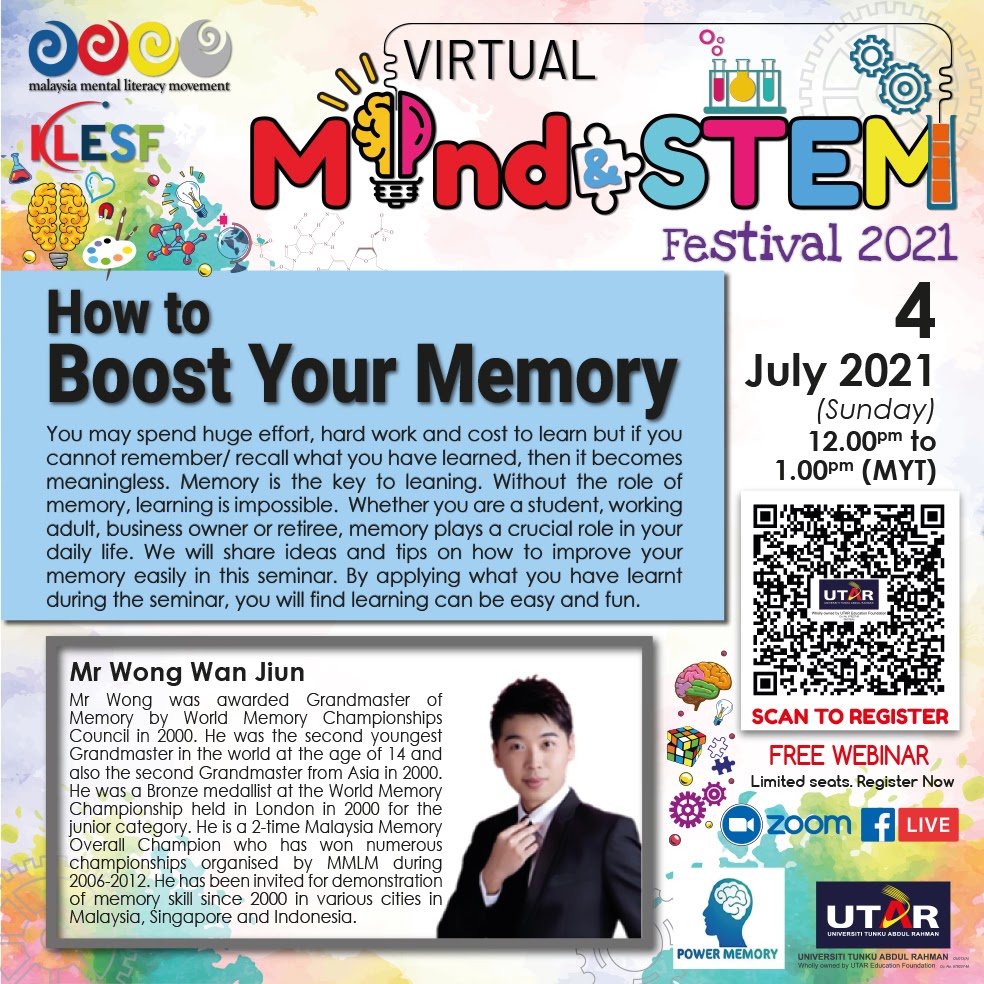

A webinar titled “How to boost your memory” was conducted on 4 July 2021 via
Zoom. Held as a part of the
Virtual Mind
& STEM Festival 2021 programme, the webinar aimed to share ideas and
tips on how to improve memory easily in a practical way.
Present to deliver the webinar was Grandmaster of Memory (GMM) Wong Wan
Jiun, who became the second youngest Grandmaster in the world at the age of
14 and the second Grandmaster in Asia in the year 2000. Wong was Malaysia’s
Memory Overall Champion two times. He is the founder of Power Memory and the
vice president of Malaysia Memory Sports Organization.
.png)
Wong’s interactive and lively webinar
Wong began his webinar by asking the participants “what do they know about
learning”. He then said, “There are four levels of learning, namely Level 1
- unconscious incompetence; Level 2 – Aware of your weakness and searching
for help because you recognise there is room for improvement; Level 3-
learning and trying some skills; Level 4 - unconscious competence.”
He pointed out that many people believe that they are either born smart or
stupid, “You might think that some people are gifted with smart brains. The
fact is, our brain can be trained. Everyone, no matter how old he or she is,
has great mental potential.” He then added, “Human beings use not more than
10 per cent of the brain’s capacity, therefore imagine if you could access
more than 10 per cent.”
.png)
Wong explaining the roles of the left and right brain
Wong mentioned that our brain is divided into two halves; the right
hemisphere controls the creative side while the left controls the analysis
side. He said, “We use the left side of our brain for thinking about things
like words, numbers and lists and it tends to store short-term memories. As
for the right brain, we will use it when we are using our imagination and it
tends to store long-term memories.”
.png)
Wong showing what the brain loves
According to him, we need to make friends with our right brain, by linking
information together with a memorable story, so that it will be easier for
one to retrieve the information. The left brain will recall information from
the right brain. He said, “Using a combination of visuals and colourful
pictorial images while studying is more advantageous for remembering
information than words alone. Your brain does not think in a straight line.
Reading by memorising words does not always work well. Instead, try
imagining a situation where you have to tell someone a story. That could
make it easier for you to memorise.”
Wong emphasised how visualisation and association work as a memory
technique, “With the visualisation and association technique, words or
information will be easier to remember. The brain is more perceptive towards
pictures, so it stores them for a longer time instead of words, thus, you
should visualise and come out with a storyline to remember them more
easily.”
Throughout the entire webinar, Wong conducted memory tests with the
participants to test their memorising skills. He also tested the
participants to see how well they could remember words and items using the
memory technique.
.png)
.png)
Wong conducting memory tests for the participants (left) and teaching them
to categorise it to memorise better (right)
.png)
.png)
.png)
.png)
Wong encouraging participants to use their imagination to visualise the
words into pictures and storyline
Nearing the end of the webinar, Wong shared some tips to revise and learn
effectively. He explained, “Most revision is boring because we do it in a
way that is boring for our amazing, creative and powerful brains. What our
brains really crave is colour and excitement which will help our brains to
focus and concentrate. This will make a difference in our ability to
remember things. Therefore, colour and pictures help us to use both sides of
our brains and make it easier for us to think, plan, organise, remember and
take control.”
He concluded, “Learning is ‘understand + remember + apply’. Our brains love
pictures, therefore use the pictorial (right) side of your brain when you
are learning or doing revision. You may draw pictures or use colours to
remember better. Also, you may practice Mind mapping, our brains are able to
remember the facts and ideas that go with them by using Mind maps.”
The webinar then saw an active interaction between the speaker and the
participants. The talk ended with an extensive yet insightful Q&A session.
To view the full video, click
here.
![]()
Wholly owned by UTAR Education Foundation (200201010564(578227-M)) LEGAL STATEMENT TERM OF USAGE PRIVACY NOTICE